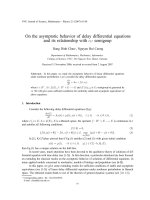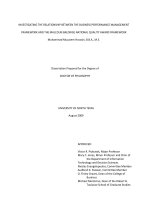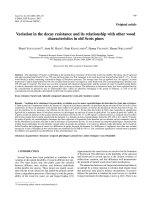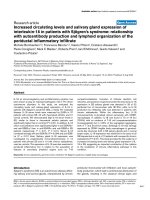BUILDING INITIAL STRATEGIC BUSINESS RELATIONSHIP WITH JAPANESE ENTERPRISES THROUGH MERGER AND ACQUISITION (ma)
Bạn đang xem bản rút gọn của tài liệu. Xem và tải ngay bản đầy đủ của tài liệu tại đây (600.25 KB, 23 trang )
FOREIGN TRADE UNIVERSITY
FACULTY OF ECONOMICS AND INTERNATIONAL BUSINESS
MID-TERM INTERNSHIP REPORT
BUILDING INITIAL STRATEGIC BUSINESS
RELATIONSHIP WITH JAPANESE ENTERPRISES
THROUGH MERGER AND ACQUISITION (M&A)
Name Nguyen Thi Khanh Huyen
Class A4 High Quality – Term 48
Instructor Dr Tran Thi Ngoc Quyen
Hanoi, August, 2012
Nguyen Thi Khanh Huyen Instructor: Dr Tran Thi Ngoc Quyen
A4 High Quality Class – Term 48
Contents
Preface
In the context of a challenging global economic situation, Vietnam has faced bouts of
macroeconomic turbulence in recent years regarding double-digit inflation, depreciating
currency, capital flight, and loss of international reserves which have eroded investors’
confidence. Therefore, how to approach external capital sources through cooperate
restructuring in line with business models should be given the priority at this time.
Merger and acquisition (M&A) is a very importance restructuring activities for
enterprises. In the world, M&A has appeared for such a long time and been popular
among countries with market economy where intense competition between
multinational corporations is unavoidable. Starting in 2000 in Vietnam, M&A activities in
general still confronting a number of obstacles that put the brake on the expansion of
this market. In the seminar held in March 2012, Dr Vu Tien Loc – President of Vietnam
Chamber of Commerce and Industry (VCCI) cited three primary reasons for this problem.
Firstly, Vietnam lacks legal framework exclusive for M&As which causes much troubles
to management agencies, businesses and finance consultants. Secondly, M&As are quite
new and complex, hence, the support of involved organizations is still limited. Finally,
relatively tight liquidity conditions constrain M&As breakthrough domestically and
internationally. However, Mr Nguyen Tuan Anh, Head of Vietnam M&A Forum 2012 also
Foreign Trade University. August 2012
2
Nguyen Thi Khanh Huyen Instructor: Dr Tran Thi Ngoc Quyen
A4 High Quality Class – Term 48
said that the country now ranked 8th among nations which witnessed the busiest M&A
activities in the Asia-Pacific region, adding that the total M&A transaction value of the
region, excluding Japan, reached $92.4 billion. The fact that GDP growth by 6% and the
target of attracting domestic and foreign investment capital and developing all kinds of
markets make Vietnam more potential to increase M&A activities both in quality and
quantity.
Why Japan?
Vietnam – Japan have enjoyed a friendly relationship and a multilateral co-operation for
such a long time. Japan has a strong development of M&A activities and always
considers Vietnam a destinated location for foreign investment. Although having
experienced a terrible earthquake Tsunami and nuclear crisis in 2011, it has basically
recovered and is enjoying higher growth. Among over 20 countries having their
companies doing M&A in Vietnam, Japan comes as the first place in terms of quantity as
well as quality. In 2011, Japan had 16 M&A deals with Vietnam which accounted for 23%
of the deal value totally. Addressing the importance of Japanese partners, in this report,
I would like to analyze the characteristics of Japanese enterprises in a M&A transaction,
understand their requirements for Vietnamese counterparts to suggest some areas that
Vietnamese firms should focus if they want to attract Japanese investors. I also highlight
the role of VCCI, especially the International Relation Department where I am currently
doing my internship, in promoting M&A between Vietnam and Japan.
Foreign Trade University. August 2012
3
Nguyen Thi Khanh Huyen Instructor: Dr Tran Thi Ngoc Quyen
A4 High Quality Class – Term 48
Chapter I: Introduction to Vietnam Chamber of Commerce and
Industry (VCCI)
1. History
The Vietnam Chamber of Commerce and Industry is a national and independent
organization of the Vietnamese business community. It is devoted to accelerating socio-
economic development of the country and promoting commercial, economic and
technological cooperation between Vietnam and the rest of the world, on the basis of
equality and mutual benefit.
Experiences of nearly 40 years and its large membership base have made the Chamber
an indispensable bridge to connect Vietnamese and foreign businesses, as well as the
business community and Vietnamese Government. The Chamber has greatly contributed
to the improvement of business environment in Vietnam and efficiently assisted
domestic and foreign entities in their business operations in Vietnam.
Founded in 1963 in Hanoi, the Vietnam Chamber of Commerce and Industry (VCCI),
originally named Chamber of Commerce of the Democratic Republic of Vietnam, served
the promotion of trade between Vietnam and other countries in the world. With only 93
member organizations at the foundation convention, the Chamber has undergone
several phases of evolution corresponding to different periods of Vietnam 's history.
Foreign Trade University. August 2012
4
Nguyen Thi Khanh Huyen Instructor: Dr Tran Thi Ngoc Quyen
A4 High Quality Class – Term 48
During the years of war, the Chamber focused activities on maintaining trade relations
between Vietnam and certain countries and territories in response to the export -
import demand of the country.
After the war, the Chamber expanded its activities all over the country, established
relations with more and more countries in the world and involved in its fold an
increasing number of economic entities. In 1982 the Chamber renamed itself the
Chamber of Commerce and Industry of the Socialist Republic of Vietnam so as to expand
its scope of operation to manufacturing sectors.
Since the "opening up" of Vietnam, the Chamber has embarked on a new phase of fast
development in its own history with its Second National Congress in 1993, Third National
Congress in 1997, and Fourth National Congress in 2003. It continued to develop the
scope and scale of its activities in keeping with the pace of the development of the
country. Through its activities both in Vietnam and abroad, the Chamber has actively
contributed to the renovation of the country, playing a significant role in the economic
growth and transformation of the nation and the integration of Vietnam in the regional
and international markets.
2. Function
At the recent National Congress (March 28-29, 1997) the Vietnam Chamber of
Commerce and Industry adopted new statutes. According to the present statutes the
Chamber is a national organization, which assembles and represents business
enterprises of all economic sectors and business associations in Vietnam. The purpose of
the Chamber is to protect and assist business enterprises to contribute to the socio-
economic development of the country, and to promote commercial, economic and
technological relations between Vietnam and other countries in the world on the basis
of equality and mutual benefit.
Foreign Trade University. August 2012
5
Nguyen Thi Khanh Huyen Instructor: Dr Tran Thi Ngoc Quyen
A4 High Quality Class – Term 48
The Chamber is an independent, non-governmental organization enjoying the status of
juridical person and operating on financial autonomy. It has the following functions:
• To represent the Vietnamese business community for the promotion and
protection of its interests in domestic and international relations.
• To promote and offer assistance in trade and investment, economic and
technological co-operation and other business activities of enterprises in Vietnam and
abroad.
3. Activities
• To collect and study the views and suggestions of business enterprises for
reflection, recommendation and advice to the State on legal matters and economic
policies for the improvement of the business environment;
• To participate in the formation and implementation of the strategy for socio-
economic development and international economic integration, to participate in the
conferences, and missions for economic and trade negotiations in line with State
regulations;
• To organize forum, dialogue, and meetings between business enterprises,
labor users (employers) and governmental agencies, between business enterprises and
the representative of workers (employees) and other relevant domestic and foreign
organizations for the exchange of information and views on matters relating to
businesses environment;
• To conduct necessary activities for the protection of the legitimate interests of
business enterprises and labor users (employer) in domestic and international business
relations;
• To organize activities for the promotion and encouragement to business
enterprises on the strict observance of laws, improvement of social accountabilities,
good business ethics and culture and sound working relations, protection of
Foreign Trade University. August 2012
6
Nguyen Thi Khanh Huyen Instructor: Dr Tran Thi Ngoc Quyen
A4 High Quality Class – Term 48
environment, and participation in other social activities in line with the Chamber's
objectives;
• To assemble and align with business associations in Vietnam, to co-operate
with chambers of commerce and industry, and relevant organizations in foreign
countries, to join international and regional organizations in line with the objective of
the Chamber and to help business enterprises participate in those organizations’
activities.
• To conduct activities for the development, promotion and improvement of the
reputation of the business enterprises, entrepreneurs, commodities of Vietnam; to
promote business supporting services; to assist businesses in developing trade and
investment relations in Vietnam and abroad through such approaches as : match-
making, seeking partners, providing information, guidance and consultancy to
businesses; organizing study, market research, seminars, conferences, trade fairs,
exhibitions, advertisements, and other promotional activities;
• To organize training activity in appropriate forms to develop the human
resources for business enterprises, to help entrepreneurs enhance their knowledge,
management skills and business capacity;
• To help in the registration and protection of intellectual property and
technology transfer in Vietnam and abroad.
• To issue Certificates of Origin for Vietnamese export commodities and to
certify other necessary commercial documents, and the cases of force majeure.
• To help domestic and foreign business enterprises in settling discrepancy,
disputes through negotiation, mediation or arbitration, and to conduct in general
average adjustment, if requested.
• To conduct other activities which are assigned by the Vietnamese State or by
other organizations.
Foreign Trade University. August 2012
7
Nguyen Thi Khanh Huyen Instructor: Dr Tran Thi Ngoc Quyen
A4 High Quality Class – Term 48
Chapter II: Boosting M&A between Vietnam and Japan through
understanding our partner.
1. M&A of Japanese enterprises in Vietnam
1.1 Trend of Japanese outbound M&A
In recent years, inbound M&A in Japan has slowed to a trickle while outbound M&A has
rapidly increased, reaching a record of $86 billion in 2011. While the strong increase of
the Japanese Yen against other currencies can partially explain this trend, demographic
pressures (i.e.: rapidly aging and declining population) are causing Japanese companies
to focus more on the international side of their development strategies as domestic
market seems to be unavailable for further growth.
1.1.1 Japan outbound M&A market figures
Figure 1: M&A market in Japan
Foreign Trade University. August 2012
8
Nguyen Thi Khanh Huyen Instructor: Dr Tran Thi Ngoc Quyen
A4 High Quality Class – Term 48
Source: RECOF M&A database (Collected from VCCI)
It can be clearly seen that for the last 3 years, the percentage for cross-border M&A
increased significantly from 22% in 2009 to 36% in 2011. M&A deals dramatically surged
between 2010 and 2011 after a decline in 2009 due to the effect of Lehman Shock (1).
The same trend can be looked at M&A of Japan with Asian companies. The number of
Japan M&A outbound with Asian companies also decreased in 2009, however, it grew to
a faster pace in 2010 and 2011 and surpassed the growth rate of overall Japan outbound
M&A deals.
The following bar chart will show more details about the target regions of Japanese
outbound M&A in recent years, including Asian region.
Figure 2: Number of Japan outbound M&A deals by target’s regions
Foreign Trade University. August 2012
9
Nguyen Thi Khanh Huyen Instructor: Dr Tran Thi Ngoc Quyen
A4 High Quality Class – Term 48
Source: RECOF M&A database (collected from VCCI)
Before 2009, the number of Japan outbound M&A with American companies and Asian
companies were almost the same. Since 2010, the number of Japan outbound M&A with
Asian companies has been increasing and it accounted for approximately 50% of total
Japan outbound M&A deals in 2011. It is forecasted that the M&A deals with Asia will be
still predominant in Japan outbound M&A market.
1.1.2 Background for increasing Japan outbound M&A
I have mentioned about the incentives for Japanese businessmen to seek growth abroad
and one of the most important reasons is the decreasing population and domestic
demand.
It is forecasted that Japan’s population hit its peak (aprox. 128 million) in 2007,
remained at the same level and stared to decrease gradually.
Foreign Trade University. August 2012
10
Nguyen Thi Khanh Huyen Instructor: Dr Tran Thi Ngoc Quyen
A4 High Quality Class – Term 48
Japan’s population will decline to less than 120 million in 2025, and will be approx. 100
million in 2045, reduced by 21% in comparison with that in 2007.
The aging of the population will proceed rapidly after 2010, and the age group over 65
years old will account for 38% of the population of the year 2045.
Figure 3: Estimate for Japan’s future population
Foreign Trade University. August 2012
11
Nguyen Thi Khanh Huyen Instructor: Dr Tran Thi Ngoc Quyen
A4 High Quality Class – Term 48
Source: Statistics Bureau, Ministry of Internal Affairs and Communications
Therefore, there is no shadow of a doubt that Japan outbound M&A will keep increasing
for the upcoming years, especially in Asian region which has the population that is
expected to largely surpass that of developed countries and domestic demand is
boosted by continuous economic growth.
1.2 Japanese enterprises’ interests in Vietnamese market
It can be claimed that Japanese companies are highly interested in Vietnam (after China
and India) (VCCI annual report on Japan 2011).
In 2011, there was a survey conducted by Price water house Coopers Co.LTD of Japanese
listed companies and leading privately owned companies. Below are 2 question
extracted from the survey:
Q1: “Which countries among BRICs, VISTA, Malaysia, Thailand and Singapore are you
interested in as a possible investment destination through M&A?”
Q2: “What is the attractive point of investing in Vietnam”
The answer to these questions are shown in the following bar charts
Figure 4: Question 1
Foreign Trade University. August 2012
12
Nguyen Thi Khanh Huyen Instructor: Dr Tran Thi Ngoc Quyen
A4 High Quality Class – Term 48
Source: Pricehousewater Coops Co.LTD “White paper 2011 on Merger and Acquisition in Japan”
Figure 5: Question 2
Foreign Trade University. August 2012
13
Nguyen Thi Khanh Huyen Instructor: Dr Tran Thi Ngoc Quyen
A4 High Quality Class – Term 48
Source: Pricehousewater Coops Co.LTD “White paper 2011 on Merger and Acquisition in Japan”
The M&A between Vietnam and Japan took off when Vietnam joined WTO in 2007. After
the Lahman Shock, the number of M&A deals between Vietnam and Japan increased
significantly in 2011 (18, by 80% compared to 2010) and that upward trend is expected
to continue. Among that, the share of “acquisition of majority stake” transaction is high.
That means, Japanese companies prefer to entering Vietnamese market by cooperating
with Vietnamese firms with market shares and information on the market. Some
companies also think that acquisition of minority stake can limit their investment risk.
Look at the top 20 deals between Vietnam and Japan by transaction value (RECOF M&A
database), 5 of them are “acquisition of majority stake” and the rest are “acquisition of
minority stake”
Figure 6: Number of Japan outbound (IN-OUT) M&A between Vietnam by target sectors
Source: RECOF M&A database
Foreign Trade University. August 2012
14
When considering M&A deals with Japanese companies, “sale of majority stake” transactions
Nguyen Thi Khanh Huyen Instructor: Dr Tran Thi Ngoc Quyen
A4 High Quality Class – Term 48
Manufacturing includes mining, foods, chemicals, steel products, machinery, transport
equipment, etc
Commerce includes retail and wholesale
Finance includes banks, securities, commodity future, insurance and miscellaneous
finance
Services, etc. includes transport, telecom, broadcasting, real estate, software, services,
etc
2. Japanese companies’ needs for M&A in Vietnam
2.1 Transaction types
As mentioned above, Japanese enterprises are interested in both “acquisition of
majority stake” as well as “acquisition of minority stake”.
The transaction type, hereafter, can be divided into 2 main fields:
• Acquisition (acquisition of majority stake): acquisition of the controlling interest
of a company, step-up acquisitions of the controlling interest of a company
• Capital participation (acquisition of minority stake): joint management of a
company (joint venture), solidifying the business alliance with equity investment
2.2 Functions to be required
• Production: products for the Japanese market (at competitive cost), products for
Vietnamese, Southeast Asia and China (alternative production sites to Thailand
and China)
Foreign Trade University. August 2012
15
A wide range of sectors has been targeted, while the percentage of manufacturing sector
has been increasing seen 2009
Nguyen Thi Khanh Huyen Instructor: Dr Tran Thi Ngoc Quyen
A4 High Quality Class – Term 48
• Sales and service: the Vietnamese market (nationwide network), Southeast Asia
and China
• Other capabilities: design consignment , product development, etc
2.3 Target industries
A wide range of industries including packaging, food, paper & pulp, transportation,
construction, financial service, IT service, etc
Figure 7: Top 20 M&A deals between Japan and Vietnam
Source: RECOF M&A database
As can be seen from the table above, top 20 deals of M&A between Japan and Vietnam
cover many sectors indicating the various interests of Japan enterprises in Vietnamese
market. Those industries areas indicate Japan’s bet on nearly 90 million Vietnamese
consumers’ purchasing power and potential market segmentation.
Foreign Trade University. August 2012
16
Nguyen Thi Khanh Huyen Instructor: Dr Tran Thi Ngoc Quyen
A4 High Quality Class – Term 48
2.4 Transaction size (by investor company size)
• Large companies: US$ 10 – 30 million or more
• Medium – sized companies: US$ 5 million or more
3. Characteristics of Japanese companies in the M&A transactions
3.1 Selection of target companies
Japanese companies often seek for companies that focus on sector of production
technology (manufacturing sector) and financial service as it is their comparative
advantage. M&A with Japanese firms is mainly conducted through technology transfer
and consultancy. They take product quality seriously when considering a M&A
transaction with any other firms. They also regard sales channels (retail or wholesale)
and brands already existed on the market as a matter of judgment. The one that they
cooperate with should guarantee on their reputation on the market by information
disclosure and transparency.
Even in discussing Japanese business custom and efficiency, Japanese management
system is sometimes criticized as not being transparent. This is because this system only
works in Japan and not compatible with global standard, for example lifetime
employment, seniority-oriented pay system, a style of management system that gives
importance to affiliated companies and cross-shareholdings with friendly companies.
That does not change much but Japan management style is more flexible than that in
the past and they demand high from their counterparts overseas. That characteristic of
Japanese management style raises the question to Vietnamese firms if they want to
work well with each other.
Foreign Trade University. August 2012
17
Japanese companies have needs for Vietnam in investment in various transaction types to
acquire various functions and in various industries
Nguyen Thi Khanh Huyen Instructor: Dr Tran Thi Ngoc Quyen
A4 High Quality Class – Term 48
3.2 Deal structure
As mentioned above, when considering M&A deals with Japanese companies, “sale of
majority stake” transactions are available as well as “sale of minority stake”. Although
acquisition of minority stake can limit financial and management risk, Japanese
enterprises are willing to take majority if control of business is necessary.
Due to the lack of management resources at the Japanese companies and to the needs
for avoiding business and financial risk during transitional period, form of partnership is
also taken in to consideration by Japanese investors. They care about the existing
management and shareholders to stay at companies to make sure that this system is
consistent with their expectation.
Recent data has shown that Japanese companies have inclination to invest on small and
medium Vietnamese enterprises with certain advantages. If the 577-million-value
transaction between Mizuho and Vietcombank is excluded, the average value of each
transaction between Vietnam and Japan is only 13 million. We can totally see that such
small transactions cannot come from any companies from America or Europe. In figure
7, 15/20 top deals are below 100 million US$ and focus on bank, securities, IT and
wholesale. That should be looked at when a Vietnamese firm wants to attract Japanese
enterprises to a M&A transaction.
3.3 Decision making process
Different from Vietnamese decision making process style which is so call “top down”
when big contracts can be come to agreement over a carousal, Japanese managers have
the contradicted approach.
In general, Japanese enterprises take relatively long time to consider a M&A transaction.
This can be explained by their incentive when making the deal. Japanese enterprises’
driven investment purpose is strategic rationales rather than money thus they spend
more time on studying the synergy effects of the transaction.
Foreign Trade University. August 2012
18
Nguyen Thi Khanh Huyen Instructor: Dr Tran Thi Ngoc Quyen
A4 High Quality Class – Term 48
Normally, when evaluating a M&A transaction, Business Development Department along
with Plan Department cooperate with specialized department to work on the project
before submitting it to the Head or investment council. This process usually takes 1 to 2
years.
As they focus much on the prior step, the basic stance to do the deal rarely changes
once the decision is made. Therefore we can see how credibility value is essential to
Japanese people. Once the commitment is made for the partnership, Japanese
companies rarely withdraw from the project or the market.
=> Knowing this characteristic, Vietnamese businessmen should be patient when dealing
with Japanese firms. They should show Japanese partners how the transaction will bring
benefits to the companies and value to their brands, not the profitability that they will
gain alone.
4. Conclusion
The statistics recently demonstrate that the number of outbound M&A of Japanese is
increasing rapidly as the decreasing domestic demand is not a short-term phenomenon
and many Japanese companies are eager to expand business to the areas where
population and economic growth can be expected.
Many of them are highly interested in doing M&A in Asia and Vietnam ranks the third as
attractive destination after India and China. Japanese firms look at Vietnam as the
growth market as well as production base. A wide range of industries are targeted and
potential needs exist in various fields.
Some Japanese companies prefer to cooperate with Vietnamese partners by taking
minority stake while some other require the majority stake to take control of the target
companies. Deal structure can be chosen depending on each company’s strategies.
Foreign Trade University. August 2012
19
Nguyen Thi Khanh Huyen Instructor: Dr Tran Thi Ngoc Quyen
A4 High Quality Class – Term 48
It is of prime importance to understand our target partner before giving them the
proposal. I hope that through this midterm-report, we can know partly more about the
Japanese business style as well as their demand. That should be carefully considered by
Vietnamese firms if they want to enter a deal with Japanese counterparts. However, for
the scope of this report, I can not go into detail of each fractions. The main content here
is taking first step in exploring how to start and what to expect from a M&A transaction
with Japanese firms.
Thanks to my internship period in International Relation Department of Vietnam
Chamber of Commerce and industry, I have chance to gain access to some valuable
information and conversation with the staff specializing in Japanese market. I will
introduce more about the role of VCCI in promoting trade between Vietnam and Japan
in the next part.
5. Role of VCCI in trade promotion between Vietnam and Japan
5.1 Information supply
- Updates nearly 1000 newsletter last year Website www.vinajapan.com
- Maintain and develop E-info gateaway between Vietnam and Japan. Until 12/2011,
there are 1.6 million views and 2 200 companies registed on E-commerce market
Vietnam – Japan with 1 214 products and 600 offers.
- Support Vietnamese enterprises in attending trade fairs and exhibitions in Japan.
5.2 Trade and investment promotion activities
Since 2009, VCCI has conducted many activities to promote trade and investment
between Vietnam and Japan. For example:
- Forum “ASEAN – Japanese enterprises” (30/9/2009) in Ho Chi Minh city attract 100
delegates from Japan and over 200 Vietnamese companies.
Foreign Trade University. August 2012
20
Nguyen Thi Khanh Huyen Instructor: Dr Tran Thi Ngoc Quyen
A4 High Quality Class – Term 48
- Seminar “Handicraft product export promotion into Japan” (25/1/2010) provided
information on Japanese consumers’ taste and the way to enter Japanese market by 2
Japanese experts on designing and marketing.
- Seminar “ Experience on business management and behavior culture of Japanese” in
Haiphong city (12/5/2011)
- Seminar “Japan: business opportunities on cooperation and investment” in Soc Trang
province (15/7/2011)
Etc
5.3 Japanese market investigation activities
This is one of the most important activities that VCCI maintains every year to provide the
most exact and adequate information of Japanese market to Vietnamese enterprises.
The activities are quite various and beneficial. For example:
- An investigation trip for more than 30 directors of companies in construction materials,
machinery, mining to Japan (4/1/2010)
- An business trip to Nomura, Hokkaido – a seafood city in Japan. It concluded 10
companies specializing in concerned area from Vietnam seeking export-import
opportunities between 2 countries.
Conclusion: Vietnam Chamber of Commerce and Industry always try to fulfill the role of
an intermediary in trade and investion promotion between Vietnam and Japan. The
activities that VCCI has organized prove positive results to the trade turnover of Vietnam
and contribute to the long time friendly relationship between 2 countries. VCCI commits
to strengthen their plan for the upcoming years, promising that this will be an blossom
year of both sides.
Foreign Trade University. August 2012
21
Nguyen Thi Khanh Huyen Instructor: Dr Tran Thi Ngoc Quyen
A4 High Quality Class – Term 48
Reference
1. “The basics of Mergers and Acquisitions”
i .investopedia.com/inv/pdf/tutorials/ma.pdf
2. “Annual report on Vietnam – Japan business forum 2009 – 2010 – 2011”, International
Relation Department, Vietnam Chamber of Commerce and Industry
3. “RECOF annual report on Japan market 2011 – 2012” on “Attracting IPO and M&A
between Vietnam and Japan” seminar, 3/2012, Hanoi
/>4. “Làm sao thu hút nhà đầu tư Nhật”, Tran Quang Thuan – General Director of Stoxplus,
6/2012
/>nhat.htm
5. E-info gateway, Vietnam- Japan business Forum
/> Foreign Trade University. August 2012
22
Nguyen Thi Khanh Huyen Instructor: Dr Tran Thi Ngoc Quyen
A4 High Quality Class – Term 48
6. Opening speech by Mr Vu Tien Loc on “Attracting IPO and M&A between Vietnam and
Japan”, 3/2012
7. “M&A in Vietnam report 2011-2012”, Stoxplus, 5/2012
Internship diary
- Support in organizing “Vietnam-Latin America business forum” (5/7/2012) and “APEC
business advisory council – ABAC” (13/7/2012)
- Support in translating documentaries and interpreting in “Vietnam-Portugal business
meeting” (9/7/2012)
- Support in contacting Vietnamese companies to inform them about the events that
VCCI was in charge.
- Support in arranging relevant papers and doing secretary work.
Foreign Trade University. August 2012
23









